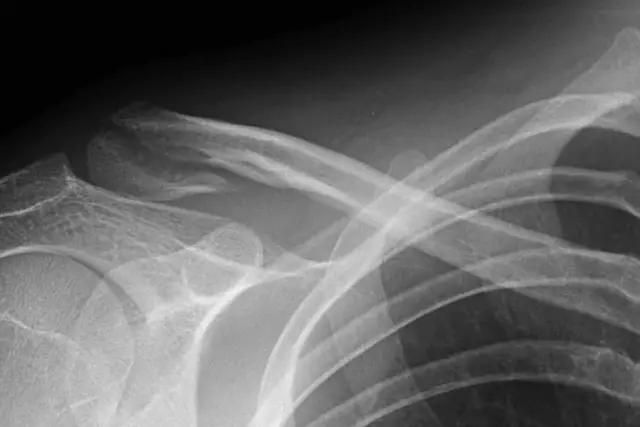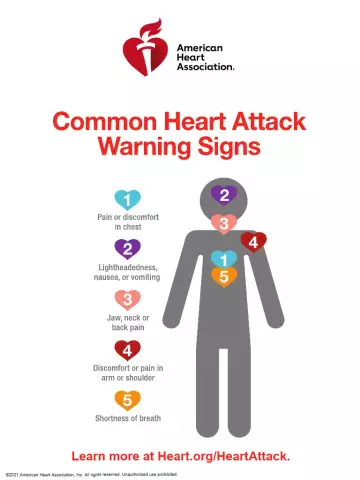- Author Rachel Wainwright [email protected].
- Public 2023-12-15 07:39.
- Last modified 2025-11-02 20:14.
First aid for fractures
Fracture is a common type of injury in which the integrity of the bone is compromised. Fractures are divided into full and partial (cracks), as well as closed, when the skin remains intact, and open - when a gaping wound appears at the site of the fracture, formed by bone fragments.
A fracture is a serious injury and always requires medical attention, therefore, in all cases where a fracture is suspected, it is necessary to seek medical help. The purpose of first aid for fractures is to ensure the rest of the injured area (in order to prevent damage to muscles and tendons), if possible, relieve pain and promptly deliver the victim to the hospital for qualified medical care.
Signs of a fracture
The main signs of a fracture that has occurred are intense pain, swelling and abnormal mobility in the injured area. There are additional signs that depend on the type and location of the fracture, but in order to suspect a fracture, three main, and sometimes even one - severe pain are enough. The fact is that swelling is not always visible to the inexperienced eye. For example, in people of a dense build, it can be difficult to detect, and in some cases it may not be too pronounced. As for pathological mobility, it also cannot always be detected, for example, if the fracture is located close to the joint.
The doctor will be able to accurately determine the presence of a fracture after taking an X-ray, and for first aid, any bone injury that is accompanied by severe pain that increases when trying to move will be considered a fracture. If later it turns out that the injury is less serious, for example, a bruise or dislocation, and first aid is provided as with a fracture, this will not bring any harm to the victim, while underestimating the severity of the injury can lead to very serious complications.
First aid measures for fractures
First aid for a fracture is immobilization, i.e. immobility of the injured part of the body, and the prompt delivery of the victim to a medical facility. When carrying out immobilization, it is important to follow the general rules:
- There is no need to try to shape the injured bone into the correct shape. This can lead to painful shock, as well as additional (secondary) trauma to soft and hard tissues;
- If the fracture is open and the fractured areas of the bone are visible, do not try to "push" them into the soft tissues. With comminuted fractures, you do not need to try to remove or set the fragments. It is necessary to immobilize in the position in which the affected area is located at the time of first aid;
- It is impossible to transport a victim with multiple injuries, including multiple fractures, as well as with fractures of the spine and pelvis. First aid for fractures of this type is provided on the spot, and an ambulance is taken to the hospital;
- With intense pain, you can give the victim anesthetic. Paracetamol, Analgin, or any other over-the-counter pain reliever will do;
- In the cold season, it is necessary to ensure that the victim does not overcool, including that the injured limb does not overcool. To do this, you can throw something from warm clothes or a blanket on her, and give the victim hot tea (if possible).
Immobilization rules for various fractures

Before transporting the victim to the hospital, the affected area must be secured so that movement in this area does not aggravate the injury.
Fractures of fingers and toes:
In case of fractures of fingers or toes, it is enough to bandage the injured finger to the neighboring one for immobilization.
Limb fractures:
For limb fractures, a splint is applied. The splint can be made from any material at hand that is strong enough to keep the limb stationary.

It is necessary to apply a splint, observing the following rules:
- The splint is installed in such a way as to fix at least two joints - located above and below the fracture site;
- There must be a tissue layer between the tire and the skin;
- The tire must be firmly fixed, it is unacceptable that it dangles, because in this case, instead of a means of immobilization, it turns into an additional traumatic factor.
Rib fractures:
In case of rib fractures, the victim needs to apply a tight, pressing bandage to the chest, the purpose of which is to exert sufficient pressure so that the person breathes more due to the abdominal muscles - this will provide fixation and reduce pain, since the chest moves during breathing. You should not talk to the victim, as speech also leads to increased pain.
Fractures of the spine and pelvis:
In case of fractures of the spine and pelvis, as well as multiple fractures, the victim should not be moved, it should be done by people with sufficient qualifications. However, if there is no such possibility, in order to provide first aid for fractures of this type, it is necessary to make a stretcher with a solid base, observing maximum precautions, to shift the victim onto them. It is necessary to put a roller of fabric under the knees (you can use rolled-up clothes), then fix the patient on a stretcher with wide bandages or tissue replacing them and transport without making any sudden movements.
First aid for open fractures
First aid for open fractures generally consists of the same measures as for closed ones, but in this case it is necessary to stop the bleeding, since a large blood loss is more dangerous than the most complex fracture. To stop bleeding, a bandage should be applied, and, if necessary, a tourniquet (see "First aid for bleeding"). It is advisable to treat the surface of the wound with an antiseptic (alcohol, iodine), but do not remove pieces of tissue, fragments, etc. from the wound.
Found a mistake in the text? Select it and press Ctrl + Enter.






